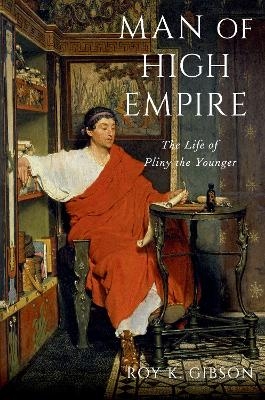
Man of High Empire
The Life of Pliny the Younger
Seiten
2022
Oxford University Press Inc (Verlag)
978-0-19-765483-5 (ISBN)
Oxford University Press Inc (Verlag)
978-0-19-765483-5 (ISBN)
Pliny the Younger (c. 60-112 C.E) - senator and consul in the Rome of Domitian and Trajan, eyewitness to the eruption of Vesuvius in 79 C.E., early "persecutor" of Christians on the Black Sea - remains the best documented Roman individual, other than emperors, between Cicero and Augustine.
Pliny the Younger (c. 60-112 C.E.)--senator and consul in the Rome of emperors Domitian and Trajan, eyewitness to the eruption of Vesuvius in 79, and early 'persecutor' of Christians on the Black Sea--remains Rome's best documented private individual between Cicero and Augustine. No Roman writer, not even Vergil, ties his identity to the regions of Italy more successfully than Pliny. His individuality can be captured by focusing on the range of locales in which he lived: from his hometown of Comum (Como) at the foot of the Italian Alps, down through the villa and farms he owned in Umbria, to the senate and courtrooms of Rome and the magnificent residence he owned on the coast near the capital.
Organized geographically, Man of High Empire is the first full-scale biography devoted solely to the Younger Pliny. Reserved, punctilious, occasionally patronizing, and perhaps inclined to overvalue his achievements, Pliny has seemed to some the ancient equivalent of Mr. Collins, the unctuous vicar of Jane Austen's Pride and Prejudice. Roy K. Gibson reveals a man more complex than this unfair comparison suggests. An innovating landowner in Umbria and a deeply generous benefactor in Comum, Pliny is also a consul who plays with words in Rome and dispenses summary justice in the provinces. A solicitous, if rather traditional, husband in northern Italy, Pliny is also a literary modernist in Rome, and--more surprisingly--a secret pessimist about Trajan, the 'best' of emperors. Pliny's life is a window on to the Empire at its zenith. The book concludes with an archaeological tour guide of the sites associated with Pliny.
Pliny the Younger (c. 60-112 C.E.)--senator and consul in the Rome of emperors Domitian and Trajan, eyewitness to the eruption of Vesuvius in 79, and early 'persecutor' of Christians on the Black Sea--remains Rome's best documented private individual between Cicero and Augustine. No Roman writer, not even Vergil, ties his identity to the regions of Italy more successfully than Pliny. His individuality can be captured by focusing on the range of locales in which he lived: from his hometown of Comum (Como) at the foot of the Italian Alps, down through the villa and farms he owned in Umbria, to the senate and courtrooms of Rome and the magnificent residence he owned on the coast near the capital.
Organized geographically, Man of High Empire is the first full-scale biography devoted solely to the Younger Pliny. Reserved, punctilious, occasionally patronizing, and perhaps inclined to overvalue his achievements, Pliny has seemed to some the ancient equivalent of Mr. Collins, the unctuous vicar of Jane Austen's Pride and Prejudice. Roy K. Gibson reveals a man more complex than this unfair comparison suggests. An innovating landowner in Umbria and a deeply generous benefactor in Comum, Pliny is also a consul who plays with words in Rome and dispenses summary justice in the provinces. A solicitous, if rather traditional, husband in northern Italy, Pliny is also a literary modernist in Rome, and--more surprisingly--a secret pessimist about Trajan, the 'best' of emperors. Pliny's life is a window on to the Empire at its zenith. The book concludes with an archaeological tour guide of the sites associated with Pliny.
Roy K. Gibson is Professor of Classics at Durham University. His publications include Reading the Letters of Pliny the Younger: An Introduction, with Ruth Morello, and, as editor with Tristan Power, Suetonius the Biographer: Studies in Roman Lives.
List of Maps and Figures
References and Abbreviations
Introduction
Chapter 1: Pliny the Younger: Life and Letters
Chapter 2: Writing a Modern Biography of an Ancient Roman
Chapter 3: Comum
Chapter 4: Campania
Chapter 5: Rome
Chapter 6: Umbria and the Laurentine Shore
Chapter 7: Return to Comum
Chapter 8: Pontus-Bithynia
Envoi
Appendix 1: Timeline
Appendix 2: Guide to Pliny's Italy and Bithynia
Bibliography
Indexes
| Erscheinungsdatum | 16.05.2022 |
|---|---|
| Verlagsort | New York |
| Sprache | englisch |
| Maße | 237 x 155 mm |
| Gewicht | 481 g |
| Themenwelt | Geschichte ► Allgemeine Geschichte ► Vor- und Frühgeschichte |
| Geisteswissenschaften ► Sprach- / Literaturwissenschaft ► Anglistik / Amerikanistik | |
| Geisteswissenschaften ► Sprach- / Literaturwissenschaft ► Literaturwissenschaft | |
| Recht / Steuern ► Allgemeines / Lexika | |
| Recht / Steuern ► Rechtsgeschichte | |
| ISBN-10 | 0-19-765483-5 / 0197654835 |
| ISBN-13 | 978-0-19-765483-5 / 9780197654835 |
| Zustand | Neuware |
| Informationen gemäß Produktsicherheitsverordnung (GPSR) | |
| Haben Sie eine Frage zum Produkt? |
Mehr entdecken
aus dem Bereich
aus dem Bereich
Was Pompeji über uns erzählt
Buch | Hardcover (2023)
Propyläen (Verlag)
32,00 €
auf den Spuren der frühen Zivilisationen
Buch | Hardcover (2023)
C.H.Beck (Verlag)
20,00 €


